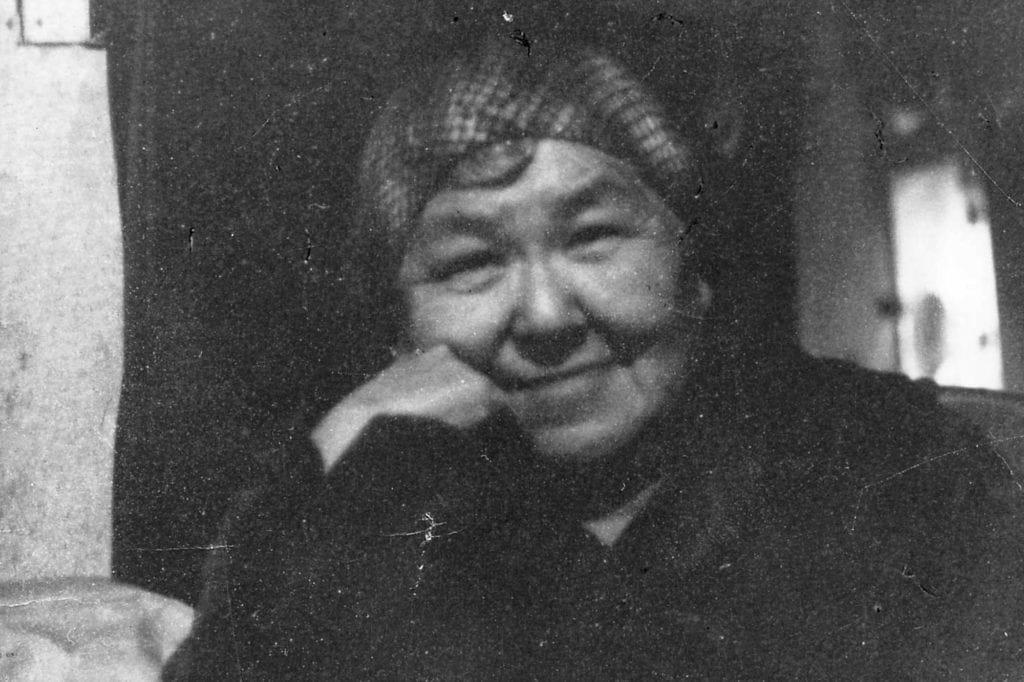
By Jen Rose Smith
For The Cordova Times
I have always been on the hunt for stories about my great-grandma Lena Saska Nacktan. My family has told me Lena was born on July 4, 1902 in Eyak territory.
By this time, the Northwestern Railroad had already been built through Cordova, and epidemics had devastated the Eyak villages at Alaganik and on the edge of Eyak lake. My great-grandma Lena survived tuberculosis, and she spent the majority of her life in a log cabin house in Old Town Cordova.
Lena brought eight children into the world. One of her daughters, Sophie, is buried at the Nirvana Park Cemetery/Eyak burial ground. Lena passed on in 1971, the same year the Alaska Native Claims Settlement Act was signed into legislation by President Richard Nixon.
Lena spoke Eyak, or dAXunhyuuga’ (meaning the words of the people), and spoke often with another Eyak woman, Minnie Stevens in our language. The two of them would visit, and as my Uncle Joe Cook relays, when he was a child they spoke and giggled in Eyak together as if it was their own little secret.
By the 1960s, speakers of dAXunhyuuga’ were small in numbers and linguist Michael Krauss made his way to Cordova and Yakutat to attempt to document our language. Among other Eyaks such as Anna Nelson Harry, Marie Smith Jones, Sophie Borodkin, Mike Sewak and George Johnson, my great-grandma Lena helped Michael to learn the words of our people.
Michael, a linguist, professor and longtime head of the Alaska Native Language Center worked to preserve all 20 of Alaska’s Native languages. He was a special advocate of documenting Eyak.
In my search to learn more about my great-grandma Lena, I wanted to ask Michael questions about her, as he had spent much time with her in the later decades of her life. I wanted to know what kind of a woman she was. Was she kind, generous? Or had she been hardened by the difficult life she lived and the many deaths she witnessed?
As a graduate student, thinking about lasting forms of colonization and the processes of knowledge production, I wanted to know: What did she think about a linguist documenting her language? Was she resistant? Perhaps a little annoyed by his persistent presence and pressing questions while she labored – taking care of her grandchildren, hauling water, putting up fish and berries? Or did she welcome the strange visitor who was intensely interested in her language, one she was onlyable to speak with a few others?
At an annual Eyak Culture Camp in 2015, I sought out Michael to ask him these questions. He described my great-grandma Lena as an intellectual, as a grammarian. He told me that she was incredibly thorough, careful and rigorous as she taught him dAXunhyuuga’. Not only was she precise and incisive, she was also sharp and held high expectations.
Michael told me that Lena liked to tease him. After months of working together, when he would become fatigued and slow after a full day of lessons in dAXunhyuuga’, Lena would chidingly insist that he was slow, perhaps dim-witted and, really, by now he should know the answers to the questions he was asking.
Michael told me that he would ask Lena to double– and triple–check his work to make sure that it was correct. My great-grandma was both his teacher and his editor. I am grateful to him for these stories that he told me.
In addition to learning our language, the Elders Michael worked with also told him stories about dAXunhyuu (the Eyak people). My great-grandma Lena and other Eyak Elders told him our stories, asked that he write down our place-names, our histories, and important information about our culture – details we now can use to learn about ourselves, our people and our language.
When Michael passed in August 2019, he left behind an immense and crucial archive of dAXunhyuuga’ at the University of Alaska Fairbanks, both digitized and in hardcopy. And he took with him a direct link to dAXunhyuu, to first-hand stories about Elders that had survived a colonial era of rapid and violent transformation to their homelands and communities.
The Eyak community will miss him, as well as the substantive connections he had made with our people and Elders.
He left with us the work that he and Lena, Sophie, Marie, Anna, Mike and George built together.
Thanks to their collaborative labors many decades ago, we now learn our language at our culture camps and language workshops. We can learn and map the place-names where dAXunhyuu lived, picked berries, gathered plants, dug clams, caught fish and were buried.
AwA’ahdah, great-grandma Lena, expert grammarian, and Michael – may you be speaking the words of the people together on the other side.
Jen Rose Smith (Eyak) grew up in Cordova. She has a PhD in ethnic studies from University of California Berkeley, and is a post-doctoral fellow at UC Davis.





